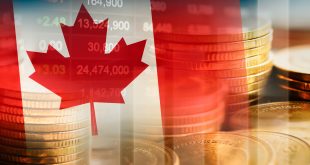On Monday, during a calm North America session, gold price was able to climb up 0.24& to $2017.50, driven by US inflation surpassing forecasts. Given that the USD has declined since last Tuesday, gold’s appeal is increased by the decreased probability of impending Fed rate cuts. In the meantime, traders anticipate the Fed’s first 25 basis point rate drop in June 2024, according to the CME FedWatch Tool.
Gold’s rise is supported by the drop in US Treasury and real yields, with a rising TIPS yield indicating increased demand for safe haven assets.
Following the release of US economic data last week that indicated inflation is still higher than the US Federal Reserve’s target, the price of gold continued to rise for three days in a row. The probability of a Fed rate cut in March and May was reduced after the Consumer Price Index and the Producer Price Index in January surprised traders by exceeding the expectation.
The dollar, which has been under pressure since last Tuesday, benefited from this. Following the most recent forecasts on inflation, traders looking for safety flocked to the yellow metal. In addition, the yield on US Treasury bonds fell, with the 10-year note, which reached a high of 4.332% this year, retracing four basis points to 4.293%.
As a result, real yields—which have a negative correlation with gold prices—dropped from Wednesday’s peak of almost 2.04% to 1.950%, as indicated by the yield on US 10-year Treasury Inflation-Protected Securities (TIPS).
Investors are currently factoring in 97 basis points of easing through 2024. Fed representatives changed their tone, using more “cautious” wording in response to the most recent US inflation data. Fed President Raphael Bostic of Atlanta implied that the Fed might be patient and that it is not in a haste to loosen policy.
“We will need to resist the temptation to act quickly when patience is needed and be prepared to respond agilely as the economy evolves,” said Mary Daly, president of the San Francisco Fed, in reference to that.
This week, the US economic schedule will feature the release of the latest FOMC Minutes alongside Fed officials’ speeches beginning on Wednesday. Traders will get further cues from US S&P Global PMIs, Initial Jobless Claims data and the Chicago Fed National Activity Index, usually a prelude to the Institute for Supply Management (ISM) Manufacturing PMI.
Technically; gold stays above 100-day SMA, eyes key resistance near $2,030. Gold´s daily chart portrays the non-yielding metal as neutral to downwardly biased despite staying above the 200-day Simple Moving Average (SMA) at $1,965.46. If buyers would like to regain control, they must challenge the 50-day SMA at $2,032.71. Once cleared, the next stop would be $2,050, ahead of the latest cycle high at $2,065.60.
Monetary policy in the US is shaped by the Federal Reserve (Fed). The Fed has two mandates: to achieve price stability and foster full employment. Its primary tool to achieve these goals is by adjusting interest rates.
When prices are rising too quickly and inflation is above the Fed’s 2% target, it raises interest rates, increasing borrowing costs throughout the economy. This results in a stronger US dollar as it makes the US a more attractive place for international investors to park their money. When inflation falls below 2% or the Unemployment Rate is too high, the Fed may lower interest rates to encourage borrowing, which weighs on the dollar.

 Noor Trends News, Technical Analysis, Educational Tools and Recommendations
Noor Trends News, Technical Analysis, Educational Tools and Recommendations




